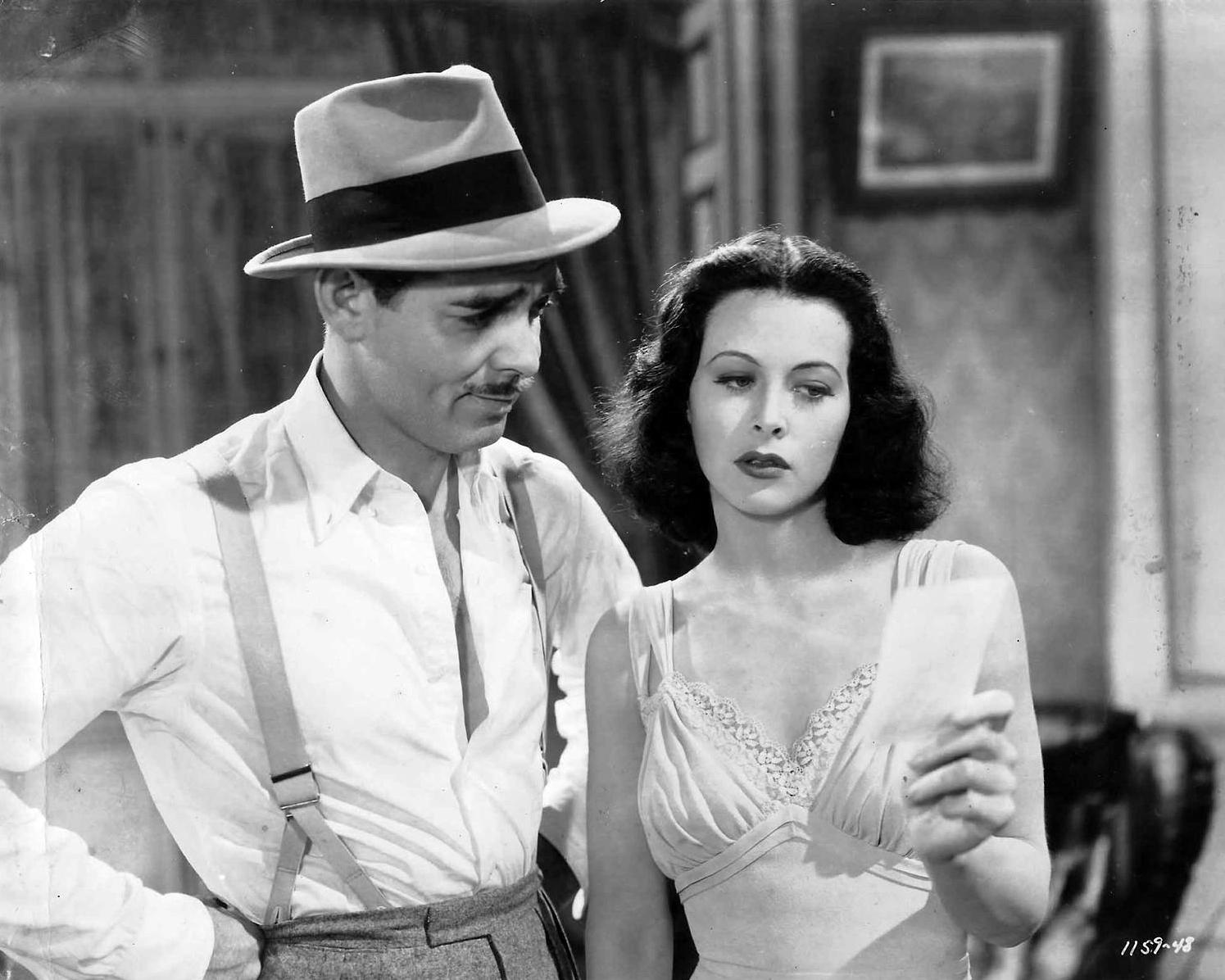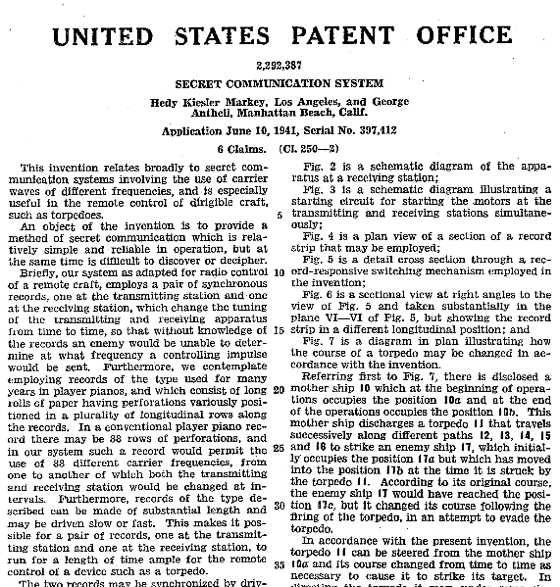

The Remarkable Inventions of Hollywood Icon Hedy Lamarr
Summary
Reflection Questions
Journal Prompt
Born Hedwig Eva Maria Kiesler, actress Hedy Lamarr is still celebrated for her captivating performances on the silver screen. What few know, however, is that the actress boasted a mind as brilliant as her visage. Alongside her cinematic achievements, Lamarr co-invented a technology that laid the groundwork for modern wireless communications, such as Wi-Fi, Bluetooth, and GPS, earning her a patent for this revolutionary work. Despite her formidable intellect and innovative prowess, Lamarr’s contributions to science and technology were overshadowed by her beauty and on-screen persona, a reflection of the significant challenges faced by women in the fields of science and technology. In this article, we explore the remarkable duality of Hedy Lamarr’s legacy—her status as a Hollywood icon and a pioneering inventor—while highlighting the barriers she encountered as a woman in a male-dominated arena. Read on to learn more.
Hedy Lamarr: Hollywood Icon


Hedy Lamarr’s career in Hollywood was nothing short of meteoric. Emigrating from Europe in the late 1930s, Lamarr quickly captivated American audiences with her striking beauty and compelling screen presence. Her role in the 1938 film “Algiers” catapulted her to stardom, establishing her as a fixture in the golden age of cinema.
Over the years, she starred in numerous successful films, including “Samson and Delilah” (1949) and “Ziegfeld Girl” (1941), securing her status as one of the era’s most glamorous and sought-after actresses. Lamarr’s allure and talent made her a Hollywood legend, embodying the glamour and sophistication of the film industry at its peak.
Hedy Lamarr: Inventor?
Despite her significant contributions to both the silver screen and the field of technology, the public’s perception of inventor and actress Hedy Lamarr was largely confined to her on-screen persona. Her beauty and acting prowess often overshadowed her intellectual achievements, trapping her in the stereotype of the glamorous film star. This typecasting made it difficult for her contemporaries and the public to acknowledge her as a serious inventor.
Lamarr’s role in developing a precursor to modern wireless communication technologies went largely unrecognized during her lifetime, illustrating the challenge she faced in breaking free from the expectations placed upon her due to her Hollywood fame. The Hedy Lamarr story highlights a broader societal tendency to overlook the multifaceted talents and contributions of women, particularly those in the public eye.
Hedy Lamarr’s Contributions to Technology


Hedy Lamarr’s foray into the world of inventions was driven by her innate curiosity and intelligence, which extended far beyond her acting career. Her interest in designing and creating was not just a pastime but a significant aspect of her intellectual life. Lamarr was self-taught and possessed a natural aptitude for science and technology.
Her inventiveness was partly inspired by her first husband, Friedrich Mandl, who was an arms manufacturer. Through him, she gained exposure to discussions on technology and science, which fueled her interest. This background, combined with her natural inclination towards problem-solving, set the stage for her groundbreaking contributions to technology.
Creating the Precursor to WiFi During World War II
The keystone of Lamarr’s inventive career came through her collaboration with composer George Antheil, leading to the invention of frequency-hopping spread spectrum technology. This innovation was conceived as a means to secure Allied communications during World War II. Lamarr and Antheil developed a secret communication system that could prevent the interception and jamming of radio-controlled torpedoes by rapidly switching frequencies among 88 channels, mirroring the 88 keys of a piano, which was Antheil’s expertise.
Hedy Lamarr, together with composer George Antheil, received U.S. Patent No. 2,292,387 in 1942 for their “Secret Communication System.” Lamar’s given name, Hedy Kiesler Markey, was featured on the patent documents. While initially the U.S. Navy did not adopt their spread spectrum techniques during the war, the principles laid out in Lamarr and Antheil’s patent became foundational to later developments in secure military communications and, eventually, technologies like Wi-Fi, Bluetooth, and GPS that we use widely today. It was this invention that led to Lamarr’s induction into the National Inventors Hall back in 2014.
The Significance of Lamarr’s Frequency Hopping Technology on Later Systems


Hedy Lamarr might not have invented WiFi, but her frequency hopping technology did lay the groundwork for several critical modern technologies. Frequency-hopping spread spectrum technology was a precursor to the secure wireless communications systems used today, including Wi-Fi, Bluetooth, and GPS.
This method of transmitting signals over multiple frequencies in a pseudorandom sequence minimizes the risk of interference and eavesdropping, making communications more secure and reliable. The principles behind their invention are now fundamental to the operation of numerous wireless devices and systems, highlighting the enduring impact of their work.
Other Inventions Imagined by Hedy Lamar
Beyond her work on frequency-hopping spread spectrum technology, Hedy Lamarr also had ideas for other inventions, though they were less well-known. Among these was a design for an improved traffic stoplight, demonstrating her interest in practical solutions to everyday problems.
Another intriguing idea was a tablet that would dissolve in water to create a flavored carbonated drink, anticipating consumer trends by several decades. While these inventions did not reach the same level of recognition or development as her work in communications technology, they further illustrate Lamarr’s broad-ranging inventive spirit and her willingness to explore solutions across different domains of science and technology.
Challenges Faced by Lamarr as a Woman Inventor


In the early to mid-20th century, societal attitudes towards women were heavily influenced by traditional gender roles, which often relegated women to the domestic sphere and discounted their intellectual and professional capabilities. For women in Hollywood, these perceptions were further compounded by the glamorization of their physical appearances, overshadowing their talents and intellect.
Hedy Lamarr, despite being a prolific actress and an ingenious inventor, was not immune to these societal biases. Her beauty and on-screen persona were frequently emphasized over her intellectual contributions, leading many to underestimate her capabilities beyond the film industry. This environment likely made it challenging for Lamarr and her contemporaries to be taken seriously as innovators and scientists, contributing to the marginalization of their work in fields dominated by men.
Hurdles Lamarr Overcame As a Woman in STEM
Lamarr faced significant hurdles in having her invention recognized and adopted, exemplifying the difficulties women inventors encountered during her time. Despite the innovative nature of her frequency-hopping spread spectrum technology, the U.S. Navy initially rejected it, citing various reasons, including the impracticality of implementing the system using the technology available at the time.
Furthermore, the lack of immediate commercial application for her invention meant that it did not receive the attention or investment it might have warranted. These challenges were not unique to Lamarr but were indicative of the broader difficulties faced by inventors, particularly women, whose contributions were often overlooked or undervalued due to prevailing gender biases and a lack of support for novel ideas.
Reception of Lamarr’s Work During Her Lifetime
Being a woman in a field dominated by men undoubtedly influenced the reception and acknowledgment of Lamarr’s work, both during her lifetime and posthumously. The novelty of her invention, coupled with her status as a woman and a Hollywood actress, likely contributed to skepticism and underestimation of her contributions. While male inventors were celebrated and supported, Lamarr’s work was largely ignored, and she received little recognition from the scientific community until much later.
This gender bias reflects a broader historical trend where women’s achievements in science and technology were minimized or attributed to their male counterparts. It was only in the latter years of her life and after her passing that Lamarr’s pioneering work began to receive the acknowledgment it deserved, highlighting the need to reevaluate and celebrate the contributions of women inventors and scientists more broadly.
Posthumous Recognition for Lamarr’s Inventions
Hedy Lamarr’s technological contributions began receiving significant recognition long after her most active years, both as an actress and an inventor. Posthumously, she has been honored with numerous awards and acknowledgments that highlight her role in the development of wireless communication technologies.
In 1997, Lamarr and George Antheil were awarded the Pioneer Award by the Electronic Frontier Foundation, and Lamarr also became the first woman to receive the Invention Convention’s BULBIE™ Gnass Spirit of Achievement Award, often regarded as the “Oscars” of inventing. These and other honors serve as belated acknowledgments of her work’s foundational impact on modern communications, offering a corrective to the historical oversight of her contributions.
Reevaluation of Her Legacy
In recent years, there has been a resurgence of interest in Hedy Lamarr’s life and work, leading to a reevaluation of her legacy as a pioneer for women in technology. Documentaries, biographies, and academic studies have explored her dual identity as a Hollywood starlet and a brilliant inventor, challenging the traditional narrative that has often overshadowed her scientific achievements. This renewed interest has helped to cement her status as a role model for women in STEM, showcasing her as a testament to the vast potential of women to contribute significantly to technological innovation, despite facing societal barriers.
Hedy Lamarr’s story has become a powerful tool in current discussions about women in STEM, serving as both inspiration and a cautionary tale. Her experiences underscore the challenges women have historically faced in being recognized in scientific and technological fields, while her eventual acknowledgment highlights the progress that has been made—and the work that still needs to be done. Lamarr’s legacy encourages a rethinking of the contributions of women to science and technology, advocating for greater inclusivity and recognition.
For future generations of women in STEM, her story is a beacon of possibility, demonstrating that intellectual curiosity and innovation know no gender bounds. It inspires continued efforts to dismantle barriers and create an equitable environment where the next generation of women scientists, technologists, engineers, and mathematicians can thrive and be celebrated.
Women’s Ongoing Underrepresentation in Tech and Science


Despite Hedy Lamarr’s life and breakthrough inventions, women continue to be underrepresented in STEM fields like electrical engineering. In the early to mid-20th century, when Hedy Lamarr was making her contributions, women’s presence in these areas was especially scarce. Recent data, however, shows gradual progress.
For example, women now earn about half of the bachelor’s degrees in science and engineering in the United States, a substantial increase from decades past. Yet, when it comes to more advanced degrees and careers in specific STEM fields, especially in engineering and computer science, women’s representation drops markedly, highlighting ongoing disparities in gender participation.
Systemic Barriers to Equal Representation in STEM Fields
The systemic barriers contributing to women’s underrepresentation in STEM are multifaceted, including stereotypes, gender bias, and a lack of female role models in these fields. Historically, these barriers were even more pronounced, with societal norms and educational systems often discouraging women from pursuing scientific and technical education.
Today, while there has been significant progress, challenges remain, such as gender bias in hiring and promotions, unequal pay, and workplace cultures that can be unwelcoming to women. Additionally, the “leaky pipeline,” a phenomenon where women drop out of STEM paths at higher rates than men at various stages of their education and career, continues to be a significant issue, compounded by the challenges of balancing career and family responsibilities.
Final Thoughts on Hedy Lamarr’s Inventions and Enduring Influence


Hedy Lamarr’s remarkable journey from Hollywood stardom to a pioneering force in the world of technology encapsulates a legacy of duality and depth that defies the conventional boundaries placed upon women of her time. Her story serves as a profound reminder of the critical need to recognize and celebrate the contributions of women in science and technology, not as novelties but as fundamental elements of progress and innovation. Lamarr’s experience underscores the importance of dismantling the systemic barriers that contribute to the underrepresentation of women in STEM fields, advocating for a culture that not only supports but champions the diverse voices and minds that drive technological advancement forward.
As we reflect on Lamarr’s enduring impact, let us commit to a future where women in STEM are not exceptions but exemplars. This calls for a concerted effort to inspire and support women to pursue their dreams in STEM, and for parents, teachers, peers, and mentors to actively encourage and uplift the women who show interest in these areas. Hedy Lamarr’s legacy is not just a testament to what has been achieved, but a beacon for what is possible when we foster an environment where every aspiring scientist, engineer, and inventor can flourish, regardless of gender.








